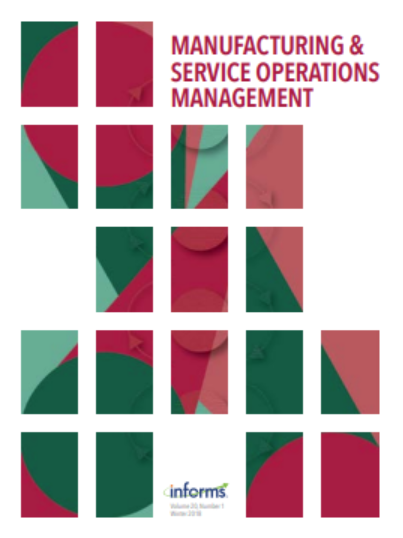供应链中概率销售对渠道动态的影响
IF 4.8
3区 管理学
Q1 MANAGEMENT
M&som-Manufacturing & Service Operations Management
Pub Date : 2023-11-02
DOI:10.1287/msom.2022.0158
引用次数: 0
摘要
问题定义:概率销售(Probabilistic selling, PS)是一种商业模式,在销售透明产品的同时,企业还销售一种不透明的商品,这种商品在购买者购买之前是未知的。我们研究了PS如何影响实体商品市场中零售商-制造商的互动,以及上游竞争如何影响渠道成员促进PS的激励。方法/结果:使用基于hotelling的多产品零售商模型,我们发现零售商通过为每种产品分配相同的概率来最大化其利润,即使产品具有不同的批发价格。我们还发现,PS缓解了双重边缘化问题带来的低效率。尽管对于去中心化渠道来说,PS的潜在好处比中心化渠道更大,但对于去中心化渠道来说,PS产生的市场条件更窄。此外,PS将渠道权力转移给制造商。然而,有可能出现三赢的结果,即制造商、零售商和消费者从PS中受益。正如预期的那样,上游竞争将渠道利润转移给零售商。然而,竞争也有令人惊讶的影响:它缩小了而不是扩大了PS的生存能力,使每个制造商都有可能从竞争对手的成本降低中受益。管理启示:如果生产成本足够低,并且产品是足够接近的替代品,制造商应该诱导零售商提供不透明的产品。如果产品差异化低(适度),制造商提高(降低)其批发价格以响应零售商提供不透明商品的能力是最优的。把批发价定在成本以下有时能使制造商的利润最大化。此外,零售商可以通过使用来自多个制造商的产品来构建不透明商品来获得战略优势。然而,零售商利用这一优势的能力被削弱了,因为它使用等概率分配放松了制造商之间的竞争。资金:S. Fay感谢雪城大学惠特曼管理学院Earl V. Snyder创新管理中心和Robert H. Brethen运营管理研究所的资金支持。补充材料:电子伴侣可在https://doi.org/10.1287/msom.2022.0158上获得。本文章由计算机程序翻译,如有差异,请以英文原文为准。
The Effect of Probabilistic Selling on Channel Dynamics in Supply Chains
Problem definition: Probabilistic selling (PS) is a business model whereby, in addition to selling transparent products, a firm sells an opaque good, which is unknown to buyers until after purchase. We examine how PS affects retailer-manufacturer interactions in markets for physical goods and how upstream competition impacts channel members’ incentives to facilitate PS. Methodology/results: Using a Hotelling-based model of a multiproduct retailer, we find that a retailer maximizes its profit by assigning equal probability to each product even when the products have different wholesale prices. We also find that PS mitigates the inefficiencies caused by the double-marginalization problem. Although the potential benefit from PS is greater for a decentralized channel than for a centralized one, the market conditions for which PS arises are narrower for a decentralized channel. Furthermore, PS shifts channel power toward the manufacturer. However, it is possible for a win-win-win outcome to arise in which the manufacturer, retailer, and consumers benefit from PS. As expected, upstream competition shifts channel profit toward the retailer. However, competition also has surprising effects: It shrinks, rather than expands, the viability of PS and makes it possible for each manufacturer to benefit from its rival’s cost reduction. Managerial implications: A manufacturer should induce the retailer to offer an opaque good if its production costs are sufficiently low and the products are sufficiently close substitutes. It is optimal for the manufacturer to increase (decrease) its wholesale prices in response to the retailer’s ability to offer opaque goods if product differentiation is low (modest). Setting a wholesale price below cost sometimes maximizes a manufacturer’s profit. Furthermore, a retailer can achieve a strategic advantage by using products from multiple manufacturers to construct opaque goods. However, the retailer’s ability to leverage this advantage is curtailed because its use of equal-probability assignments relaxes competition between manufacturers. Funding: S. Fay acknowledges the financial support from the Earl V. Snyder Innovation Management Center and the Robert H. Brethen Operations Management Institute, Whitman School of Management, Syracuse University. Supplemental Material: The e-companion is available at https://doi.org/10.1287/msom.2022.0158 .
求助全文
通过发布文献求助,成功后即可免费获取论文全文。
去求助
来源期刊

M&som-Manufacturing & Service Operations Management
管理科学-运筹学与管理科学
CiteScore
9.30
自引率
12.70%
发文量
184
审稿时长
12 months
期刊介绍:
M&SOM is the INFORMS journal for operations management. The purpose of the journal is to publish high-impact manuscripts that report relevant research on important problems in operations management (OM). The field of OM is the study of the innovative or traditional processes for the design, procurement, production, delivery, and recovery of goods and services. OM research entails the control, planning, design, and improvement of these processes. This research can be prescriptive, descriptive, or predictive; however, the intent of the research is ultimately to develop some form of enduring knowledge that can lead to more efficient or effective processes for the creation and delivery of goods and services.
M&SOM encourages a variety of methodological approaches to OM research; papers may be theoretical or empirical, analytical or computational, and may be based on a range of established research disciplines. M&SOM encourages contributions in OM across the full spectrum of decision making: strategic, tactical, and operational. Furthermore, the journal supports research that examines pertinent issues at the interfaces between OM and other functional areas.
 求助内容:
求助内容: 应助结果提醒方式:
应助结果提醒方式:


